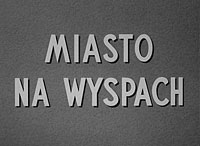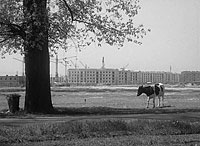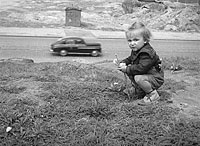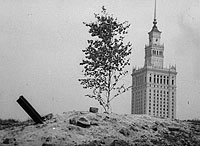 Miasto na wyspach
Miasto na wyspach
Poland, 1958, black and white, 9 mins
The rebuilding of the Polish capital is one of the most frequent themes encountered in Polish documentaries of the late 1940s and 1950s, as demonstrated by such films as Brzozowa Street/Ulica Brzozowa (1947), Return to the Old Town/Powrót na Stare Miasto (1954), Warsaw ’56/Warszawa 1956 (1956) and Where the Devil Says Goodnight/Gdzie diabeł mówi dobranoc (1956), many of which use such tactics as realism, sarcasm and oblique social commentary to describe a process that was nowhere near as smooth as the government propagandists would have preferred the people to believe.
City on Islands reaches similar conclusions, but takes a different approach to constructing its thesis. Initially, it seems to be presenting a topographical study of Warsaw on several planes – the electric cables overhead, the tramlines cutting through the streets, and the various pipes under the surface. The opening high-angle shot of the junction of Aleje Jerozolimskie and Marzałkowska establishes the shape of a cross pointing in all four directions of the compass – an image that introduces the nearby signpost indicating the distances to other European capitals. “But where is Warsaw?”, the commentator wants to know, and it’s not as absurd a question as it seems, since the film’s disturbing central thesis is that ‘Warsaw’ as an entity has changed beyond recognition since 1939 – and not just because it was bombed flat in 1944.

A contrast is immediately drawn between the way the same tramline begins running through wide asphalt streets of the city centre, then along the more traditional cobblestones of the suburbs, and finally the grassy meadows of the outskirts. But far from consisting of old-fashioned villages, they actually feature large housing estates with thousands of inhabitants – and it’s standing (or rather clinging) room only on the trams at the end of the line. The commentator reveals that Varsovians use the trams six times more frequently than they did before the war, and as a result the city centre has essentially become a gigantic tram interchange – hardly anyone walks any more, they merely hop on another tram, and head out somewhere else. The commentator laments that “the city centre does not absorb those who commute there” over a montage of trams marked with suburban destinations, anonymously passing each other like the proverbial ships in the night.
So much for transport. Now, housing – and a lively upward xylophone glissando implies that new developments are springing up all over the place. But where? As far from the centre as possible, on the extreme periphery that was formerly occupied by meadows, clay pits, forests and villages, the old-fashioned dwellings now dwarfed by anonymous blocks of flats, anything up to an hour away from the centre. Can this also be called ‘Warsaw’?

A revelatory montage of photographs from 1939 shows how things have changed. Then, the streets of the city centre were crammed with pedestrians, and the city itself was a single homogenous unity. (The commentary could have made more of this, since Warsaw 1939 was also a far more multicultural environment than it was two decades later). This Warsaw also had suburbs, but they were only built once the centre was too full – “the rules of logic”. This domestic part of the city centre was destroyed in 1944, and while the rubble has been mostly cleared away, it now consists of vast empty spaces, practically denuded of people. A woman blithely pushes her pram along the middle of a road, since there is no visible traffic to pose a threat. It’s hard to believe that these are the same streets.
The film then takes us around various compass-points only a few hundred yards from the city centre. The area is still largely in ruins, and statues look down (one raising an admonishing finger) at people eking out an existence as aimless as that of the pigeons that alight on the roof of a makeshift shack. The commentary has almost fallen silent by this point, popping up only to identify the angle from the centre (north, north-west, west, etc.) – and this is understandable, as the images are more than eloquent: there’s no need for the shock tactics of Warsaw ’56 or the sarcasm of co-director Bohdan Kosiński’s earlier The Lublin Old Town (Lubelska starówka, 1956).

Finally, after yet another shot of urban emptiness, the commentary quotes one Engineer Zelent, Deputy Chairman of the Steering Committee of the Social National Council: “In the centre, what is in the ground – the laying of gas, water and sewage pipes, electricity – is worth almost half the value of the development on the surface. Each unused square metre of ground will start screaming”. Fine words, but there’s not much screaming here – just supreme indifference of planning authority and inhabitants alike. This is Warsaw, 1958 – thirteen years after reconstruction began. As the title suggests, it’s no longer a city, merely an archipelago of only loosely connected islands.
- Directors: Jan Dmowski, Bohdan Kosiński
- Camera: Antoni Staśkiewicz
- Editor: Marian Duszyński
- Sound: Halina Paszkowska
- Music: Zdzisław Szostak
- Narrator: Janusz Kilański
- Production Manager: Andrzej Liwnicz
- Production Company: WFD
The film is included on PWA’s Polish School of the Documentary: The Black Series double-DVD set (Region 0 PAL). The source print is one of the best ones on this set, with a very sharp, clear and generally blemish-free picture with a wide dynamic range from pure white to deep black without ever falling prey to overexposure or loss of shadow detail. The sound is typical 1950s mono, but otherwise fine. The subtitles, too, are above average, with only the very occasional idiomatic eccentricity (a reference to “subvarsovian villages”, for instance) betraying that their author may not have been a native English speaker.